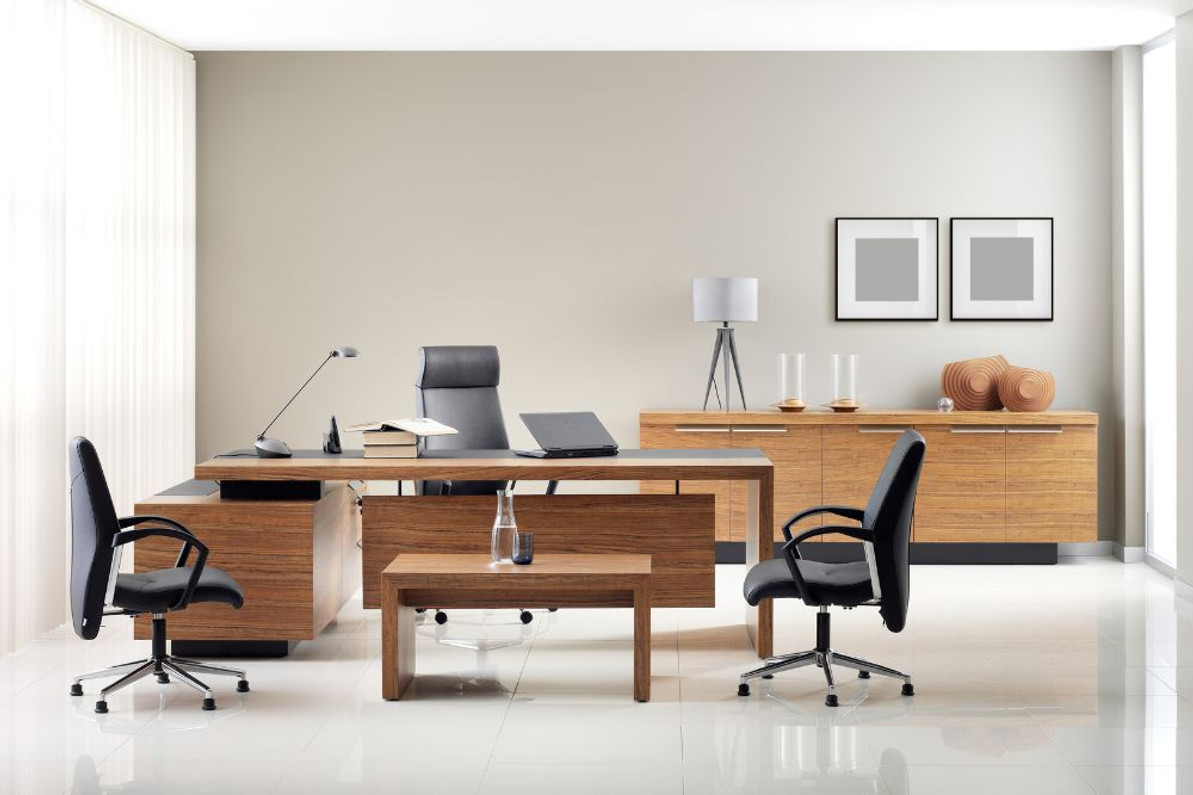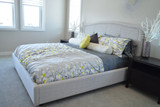Strategic Office Elegance: Masterful Tips for Arranging Your Home Workspace Furniture
A well-decorated workspace not only makes the surroundings beautiful and more functional but also inspires creativity among employees. Also, you can encourage productivity and collaboration with the right design, layout, and furniture. Here are some practical tips on how to arrange office furniture to achieve all objectives.
Mastering the Arrangement of Workspace Furniture
Creating a strategic and elegant office space involves careful consideration of both functionality and aesthetics. Here are some masterful tips for Office Furniture arrangement:
Define Your Needs: The first step to take is always hard. In this case, it is defining your needs. So, before arranging furniture, you must identify your workspace's primary functions. Ask yourself some questions like Do you need ample desk space for paperwork? Storage for files and supplies? A comfortable seating area for clients? Understanding your requirements will guide your furniture arrangement.
Prioritize Ergonomics: Invest in ergonomic furniture to promote comfort and productivity. Ensure that chairs for employee use provide proper support for the back and desk at an appropriate height to prevent strain on wrists and neck. Adding height-adjustable chairs and desks also helps reduce stress and relieve back pain, the employees' most common health problem. You can buy employee friendly furniture from Direct Marketplace.
Maximize Natural Light: Position your desk and seating areas near windows to capitalize on natural light. Natural light elevates mood and productivity and reduces the need for artificial lighting, helping to create a more sustainable workspace.
Create Zones: Divide your workspace into distinct zones based on function. For example, designate one area for focused work, another for meetings or collaboration, and a third for relaxation or breaks. Arrange furniture accordingly to delineate these zones.
Consider Traffic Flow: Arrange furniture to facilitate easy movement throughout the space. Avoid blocking pathways or creating obstacles that impede traffic flow. Consider the typical flow of people in the office and arrange furniture accordingly. Also, consider employees with mobility issues while placing the workspace furniture.
Embrace Symmetry: Symmetrical arrangements often lend a sense of balance and elegance to a space. Consider placing matching furniture pieces on either side of a focal point, such as a desk or artwork, to create visual harmony.
Scale Appropriately: Buy and use furniture proportionate to your space's size. Avoid overcrowding by choosing furniture that fits comfortably within the room's dimensions. Consider the scale of individual pieces relative to one another as well.
Incorporating Storage Solutions: Make your office clutter-free by integrating ample storage solutions into your design. Utilize bookshelves, cabinets, and drawers to organize paperwork, supplies, and personal items. Opt for multi-functional furniture pieces that offer both storage and style.
Personalize with Style: Infuse your workspace with personal touches that reflect your personality and style. Incorporate artwork, decorative accents, and plants to add warmth and character to the space. However, avoid overcrowding with too many decorative elements.
Flexibility and Adaptability: Design your workspace with flexibility in mind to accommodate evolving needs and preferences. Choose modular furniture that can be easily reconfigured to suit changing requirements. Incorporate mobile or adjustable elements that allow for customization and adaptability over time.
Tech-Friendly Solutions: These days, offices use lots of electronic stuff like printers, PCs, and networking systems. So, incorporate furniture with built-in cable management systems, power outlets, and charging stations to accommodate the technological needs of modern workplaces and keep cords organized.
Standing Meeting Tables: Install standing-height meeting tables or gathering areas to promote active engagement and energy during team meetings, brainstorming sessions, and collaborative discussions.
Now, you know how to arrange your office while maintaining the elegance of the workspace. Now let's explore some tips to upkeep the office furniture.
Best DIY Tips to Upkeep the Office Furniture in Best Condition
Maintaining office furniture is essential for preserving its appearance, functionality, and longevity. Here are some DIY tips to help you upkeep your office furniture:
Regular Cleaning: Dust, dirt, and other particulates can accumulate in chair fibers and furniture surfaces over time, so regular cleaning is essential. Use a soft cloth or microfiber cloth to wipe down surfaces gently. Use a mild wood cleaner or a mixture of water and vinegar for wood furniture. For upholstered furniture, vacuum regularly and spot clean stains with a fabric cleaner.
Protective Measures: Spills, scratches, and heat can damage the furniture. Use coasters, placemats, or desk pads to protect surfaces from damage. Encourage colleagues to use coasters for drinks and to avoid placing hot items directly on desks or tables.
Polishing and Waxing: For wood furniture, apply polish or wax periodically to restore shine and protect the wood from drying out. Follow the manufacturer's instructions and buff the surface gently with a soft cloth for a smooth finish.
Tighten Screws and Fasteners: Periodically check all screws, bolts, and fasteners on your furniture to ensure they are tight and secure. Loose screws can cause instability and compromise the structural integrity of the furniture, so tighten them with a screwdriver or wrench.
Repair Scratches and Damage: Repair minor scratches and dents in wood furniture using touch-up markers or scratch repair kits at home improvement stores. Consider refinishing or consulting a professional furniture repair service for deeper scratches or damage.
Lubricate Moving Parts: If your office furniture includes drawers, hinges, or other moving parts, lubricate them occasionally with a silicone-based lubricant to keep them operating smoothly. Be sure to clean any excess lubricant to prevent buildup and staining.
Rotate and Rearrange: It is essential to distribute the furniture weight evenly to prevent uneven wear and tear, so periodically rotate and rearrange the furniture. This will also help to give the workspace a refreshed look.
Protect Floors: Use furniture pads or felt protectors on the bottom of chair legs and table feet to prevent scratching and damage to floors, especially on hardwood or tile surfaces.
Monitor Humidity Levels: Maintain consistent humidity in your office to prevent wood furniture from warping or cracking. Use a humidifier in dry environments and a dehumidifier in humid environments to control moisture levels.
Follow Manufacturer's Guidelines: Lastly, always follow the manufacturer's care instructions and guidelines for cleaning and maintenance specific to your furniture. This will help ensure you properly care for your furniture and avoid voiding warranties.
Conclusion
In conclusion, creating a strategically arranged and elegantly furnished office space is not just about aesthetics; it's about fostering productivity, collaboration, and employee well-being. Following the masterful tips outlined in this guide, businesses can transform their workspaces into environments that inspire creativity and efficiency.
Each aspect contributes to a harmonious and functional workspace, from defining needs and prioritizing ergonomics to maximizing natural light and incorporating storage solutions. Furthermore, including maintenance tips underscores the importance of ongoing care and attention to preserve the longevity and appeal of office furniture.
Are you considering buying homeOffice Furniture? Give us a call or email to learn about the wide range of office furniture available with us.
Recent Posts
-
10 Stylish Living Room Furniture Pieces to Elevate Your Space
Your living room is the heart of your home, where you relax, entertain guests, and make memories wit …Jun 19th 2024 -
Furniture Hacks: Clever Tips and Tricks for Maximizing Space
Welcome to our guide on maximizing space with clever furniture hacks! In today's fast-paced world, w …May 19th 2024 -
The Ultimate Guide to Choosing the Perfect King-Size Bed for Your Bedroom
Are you searching for the perfect king-size bed to transform your bedroom into a haven of comfort …May 3rd 2024




